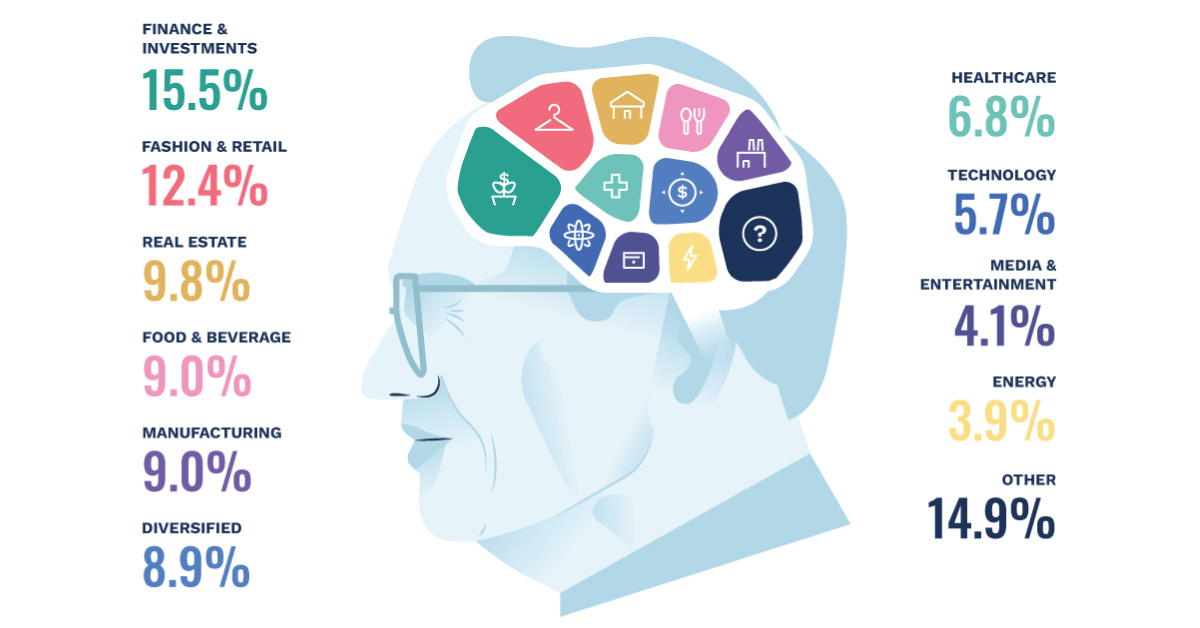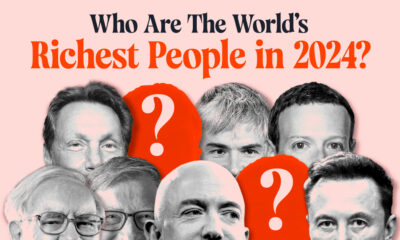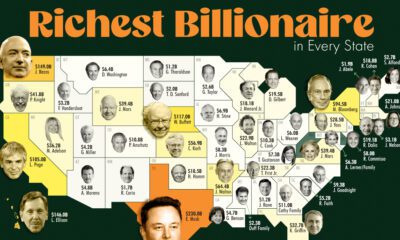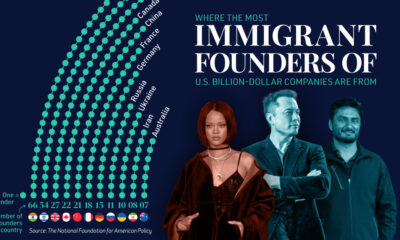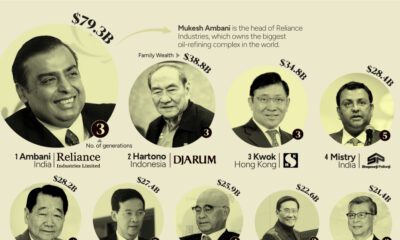Money
The World’s Billionaires, by Generation

The World’s Billionaires, by Generation
What similarities do the world’s billionaires share? What are their differences?
At the age of 12, Elon Musk built his first video game. Similarly, Mark Zuckerberg shared an interest in computer programming, building a simple messaging platform at the same age. The co-founder of Oracle, Larry Ellison, developed programming skills at college. All three span different generations and made their fortunes in tech.
In this infographic from BusinessFinancing.co.uk, we explore some characteristics of billionaires across generations, including their average net worth, top sectors, number of children, and most common city of residence.
The World’s Billionaires, by Generation
Using data from Forbes here is how each generation of the world’s billionaires break down.
Silent Generation
- Born: 1928-1945
- Average Net Worth: $5.5 billion
- Most Popular Residence: New York, U.S.
Silent Generation billionaires are the wealthiest on average across generations. With CEO of Berkshire Hathaway Warren Buffett and Zara founder Amancio Ortega among its ranks, Silent Generation billionaires are most likely to be in finance, fashion, and real estate industries.
| Top 5 | Sector | % |
|---|---|---|
| 1 | Finance & Investments | 15.5% |
| 2 | Fashion & Retail | 12.4% |
| 3 | Real Estate | 9.8% |
| 4 | Food & Beverage | 9.0% |
| 5 | Manufacturing | 9.0% |
Media mogul Rupert Murdoch, who owns The Wall Street Journal, Fox News, and The New York Post, is also part of this group. He has a net worth of $13 billion.
Baby Boomer
- Born: 1946-1964
- Average Net Worth: $4.6 billion
- Most Popular Residence: New York, U.S.
Like the Silent Generation, billionaire Boomers are most likely to be in finance. Stephen Schwarzman, founder of private equity firm Blackstone Group, R. Budi Hartono, the richest person in Indonesia, and Ray Dalio, head of Bridgewater Associates, all fall into this generation.
Boomer billionaires are much less likely to be in the tech industry, though Jeff Bezos and Bill Gates have amassed their fortunes in this area.
| Top 5 | Sector | % |
|---|---|---|
| 1 | Finance & Investments | 14.2% |
| 2 | Manufacturing | 12.9% |
| 3 | Fashion & Retail | 10.6% |
| 4 | Technology | 8.7% |
| 5 | Healthcare | 8.5% |
With a net worth of $150 billion, LVMH chair Bernard Arnault is the second richest person in the world. Francoise Bettencourt-Meyers, vice-chairwoman of L’Oreal, ranks 12th. Both fashion conglomerates are based in France and helmed by billionaire Boomers.
Generation X
- Born: 1965-1980
- Average Net Worth: $4.4 billion
- Most popular Residence: Beijing, China
The world’s billionaires in Gen X are not only predominantly in tech, but are most likely to live in Beijing, China. Ma Huateng, founder of social media conglomerate Tencent Holdings, created instant messaging platform QQ in his early 20s. Colin Huang built one of China’s largest e-commerce platforms, Pinduoduo, in 2015.
| Top 5 | Sector | % |
|---|---|---|
| 1 | Technology | 24.2% |
| 2 | Manufacturing | 13.4% |
| 3 | Finance & Investments | 11.6% |
| 4 | Healthcare | 8.0% |
| 5 | Fashion & Retail | 7.6% |
Gen X billionaires also include Elon Musk and Google co-founder Larry Page.
Millennials
- Born: 1981-1996
- Average Net Worth: $5.1 billion
- Most Popular Residence: San Francisco, U.S.
With the second-highest average net worth after the Silent Generation, millennial billionaires are seen predominantly in tech and finance. Roughly 100 billionaires worldwide fall into this category overall.
Mark Zuckerberg is the only millennial billionaire among the top 10 richest globally.
| Top 5 | Sector | % |
|---|---|---|
| 1 | Technology | 31.0% |
| 2 | Finance & Investments | 12.9% |
| 3 | Fashion & Retail | 8.6% |
| 4 | Media & Entertainment | 8.6% |
| 5 | Automotive | 6.9% |
Brian Chesky (co-founder of Airbnb), Bobby Murphy and Evan Spiegel (co-founders of Snapchat), and Swiss billionaire Guillaume Pousaz are all part of this billionaire cohort.
Generational Trends
What other trends are seen across the world’s billionaires?
| Silent Generation Billionaires | Baby Boomer Billionaires | Generation X Billionaires | Millennial Billionaires | |
|---|---|---|---|---|
| Women | 9.6% | 9.8% | 11.9% | 19.1% |
| Self-Made | 65.7% | 71.0% | 80.7% | 66.4% |
| U.S. Citizens | 38.2% | 27.3% | 17.7% | 30.2% |
| EU Citizens | 17.5% | 11.7% | 13.0% | 18.1% |
| Living Outside the U.S. | 61.9% | 73.2% | 81.8% | 65.5% |
| Married | 78.9% | 86.5% | 83.6% | 68.4% |
Millennial billionaires are the most likely to be women, with roughly double the rate of all other generations at 19%. Notable billionaire women include Anna Kasprzak, who co-owns Danish shoe company ECCO and Brazil’s Anne-Marie Werninghaus.
Self-made billionaires are most likely to be Gen X. Over 80% of billionaires are in this category, including Google co-founder Sergey Brin and Mu Rongjun, co-founder of Meituan, a company similar to Yelp. At the same time, the most billionaires living outside of the U.S. (81%) were born in this generation.
Billionaire Boomers are most likely to be married. The Silent Generation, meanwhile, are most likely to be U.S. citizens, with hedge fund manager George Soros and the world’s oldest billionaire, George Joseph (100) who founded insurance firm Mercury General, in this set.
Notable exceptions include Robert Kuok (98), the richest person in Malaysia, and Masatoshi Ito (97), chair of Japan’s largest retailer.
Money
Charted: Which City Has the Most Billionaires in 2024?
Just two countries account for half of the top 20 cities with the most billionaires. And the majority of the other half are found in Asia.

Charted: Which Country Has the Most Billionaires in 2024?
This was originally posted on our Voronoi app. Download the app for free on iOS or Android and discover incredible data-driven charts from a variety of trusted sources.
Some cities seem to attract the rich. Take New York City for example, which has 340,000 high-net-worth residents with investable assets of more than $1 million.
But there’s a vast difference between being a millionaire and a billionaire. So where do the richest of them all live?
Using data from the Hurun Global Rich List 2024, we rank the top 20 cities with the highest number of billionaires in 2024.
A caveat to these rich lists: sources often vary on figures and exact rankings. For example, in last year’s reports, Forbes had New York as the city with the most billionaires, while the Hurun Global Rich List placed Beijing at the top spot.
Ranked: Top 20 Cities with the Most Billionaires in 2024
The Chinese economy’s doldrums over the course of the past year have affected its ultra-wealthy residents in key cities.
Beijing, the city with the most billionaires in 2023, has not only ceded its spot to New York, but has dropped to #4, overtaken by London and Mumbai.
| Rank | City | Billionaires | Rank Change YoY |
|---|---|---|---|
| 1 | 🇺🇸 New York | 119 | +1 |
| 2 | 🇬🇧 London | 97 | +3 |
| 3 | 🇮🇳 Mumbai | 92 | +4 |
| 4 | 🇨🇳 Beijing | 91 | -3 |
| 5 | 🇨🇳 Shanghai | 87 | -2 |
| 6 | 🇨🇳 Shenzhen | 84 | -2 |
| 7 | 🇭🇰 Hong Kong | 65 | -1 |
| 8 | 🇷🇺 Moscow | 59 | No Change |
| 9 | 🇮🇳 New Delhi | 57 | +6 |
| 10 | 🇺🇸 San Francisco | 52 | No Change |
| 11 | 🇹🇭 Bangkok | 49 | +2 |
| 12 | 🇹🇼 Taipei | 45 | +2 |
| 13 | 🇫🇷 Paris | 44 | -2 |
| 14 | 🇨🇳 Hangzhou | 43 | -5 |
| 15 | 🇸🇬 Singapore | 42 | New to Top 20 |
| 16 | 🇨🇳 Guangzhou | 39 | -4 |
| 17T | 🇮🇩 Jakarta | 37 | +1 |
| 17T | 🇧🇷 Sao Paulo | 37 | No Change |
| 19T | 🇺🇸 Los Angeles | 31 | No Change |
| 19T | 🇰🇷 Seoul | 31 | -3 |
In fact all Chinese cities on the top 20 list have lost billionaires between 2023–24. Consequently, they’ve all lost ranking spots as well, with Hangzhou seeing the biggest slide (-5) in the top 20.
Where China lost, all other Asian cities—except Seoul—in the top 20 have gained ranks. Indian cities lead the way, with New Delhi (+6) and Mumbai (+3) having climbed the most.
At a country level, China and the U.S combine to make up half of the cities in the top 20. They are also home to about half of the world’s 3,200 billionaire population.
In other news of note: Hurun officially counts Taylor Swift as a billionaire, estimating her net worth at $1.2 billion.
-

 Mining1 week ago
Mining1 week agoGold vs. S&P 500: Which Has Grown More Over Five Years?
-

 Markets2 weeks ago
Markets2 weeks agoRanked: The Most Valuable Housing Markets in America
-

 Money2 weeks ago
Money2 weeks agoWhich States Have the Highest Minimum Wage in America?
-

 AI2 weeks ago
AI2 weeks agoRanked: Semiconductor Companies by Industry Revenue Share
-

 Markets2 weeks ago
Markets2 weeks agoRanked: The World’s Top Flight Routes, by Revenue
-

 Countries2 weeks ago
Countries2 weeks agoPopulation Projections: The World’s 6 Largest Countries in 2075
-

 Markets2 weeks ago
Markets2 weeks agoThe Top 10 States by Real GDP Growth in 2023
-

 Demographics2 weeks ago
Demographics2 weeks agoThe Smallest Gender Wage Gaps in OECD Countries
